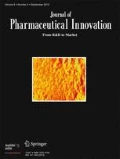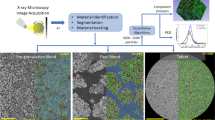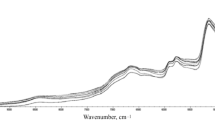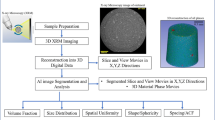Abstract
Purpose
Pharmaceutical gelatin shell capsules are commonly used to deliver powdered solid dosage forms. The dissolution behavior of these products depends on a number of factors, including, notably, powder distribution within capsules. Powder agglomeration occurring during the filling and sealing stages may lead to regulatory compliance issues. Although not a typical procedure, X-ray images of the final capsules may be inspected manually to determine the presence of such agglomerates.
Methods
The objective of this study was to develop a screening system, based on X-ray image analysis, capable of distinguishing capsules containing agglomerated powder from those containing unagglomerated powder. To do so, capsules were produced under various conditions to induce differing levels of agglomeration. Samples were first classed according to expert opinion before being tested to calibrate chemometric soft independent modeling by class analogy. As capsules were cylindrical and visually opaque, each was imaged multiple times to determine the robustness of the method to uneven powder agglomeration inside the capsules.
Results and Conclusions
The results show that X-ray imaging can automatically detect and classify powder agglomerates within pharmaceutical capsules, thus reducing reliance on subjective human inspection while increasing the online potential of capsule imaging.









Similar content being viewed by others
References
Stegemann S, Bornem C. Hard gelatin capsules today-and tomorrow, Capsugel. 1999. p. 1–23.
Cole GC. Capsule types, filling tests, and formulation. In: Ridgway K, editor. Hard Capsules. London: The Pharmaceutical Press; 1987.
Nichols G, Byard S, Bloxham MJ, Botterill J, Dawson NJ, Dennis A, et al. A review of the terms agglomerate and aggregate with a recommendation for nomenclature used in powder and particle characterization. J Pharm Sci. 2002;91(10):2103–9.
Swanepoel E, Liebenberg W, De Villiers MM, Dekker TG. Dissolution properties of piroxicam powders and capsules as a function of particle size and the agglomeration of powders. Drug Dev Ind Pharmacy. 2000;26:1067–76.
Hickey J, Crowder AM, Louey TD, Orr M, Norman. A Guide to Pharmaceutical Particulate Science. CRC Press. Boca Raton (Fl), United-States; 2003. p. 249.
De Villiers MM, Van der Watt JG. Dissolution rate a measurement of the deaggregation of Furosemide agglomerates during an interactive mixing process. Drug Dev Ind Pharm. 1990;16(8):1391–7.
Yang WL, Hsiau SS. The effect of liquid viscosity on sheared granular flows. Chem Eng Sci. 2006;61:6085–95.
List PH, Müller BW. Untersuchungen über den FST-Komplex. Pharmazeutische Industrie. 1972;34:963–72.
List PH, Müller BW. Arzneiformenlehre: ein Lehrbuch für Pharmazeuten. Wissenschaftliche Verlagsgesellschaft. Stuttgart, Germany; 1982.
Hogan J, Shue PI, Podczeck F, Newton JM. Investigations into the relationship between drug properties, filling, and the release of drug from hard gelatin capsules using multivariate statistical analysis. Pharm Res. 1996;13:944–9.
Jain R, Railkar AS, Malick AW, Rhodes CT, Shah NH. Stability of a hydrophobic drug in the presence of hydrous and anhydrous lactose. Eur J Pharm Biopharm. 1998;46:177–82.
Cheng H, Hsiau S. The study of granular agglomeration mechanism. Powder Technol. 2010;199(3):272–83.
Das SC, Behara SR, Morton DA, Larson I, Stewart PJ. Importance of particle size and shape on the tensile strength distribution and de-agglomeration of cohesive powders. Powder Technol. 2013;249:297–303.
Jamrógiewicz M. Application of the near-infrared spectroscopy in the pharmaceutical technology. J Pharm Biomed Anal. 2012;66:1–10.
Young PM, Price R, Tobyn MJ, Buttrum M, Dey F. Investigation into the effect of humidity on drug-drug interactions using the atomic force microscope. J Pharm Sci. 2003;92(4):815–22.
Thielmann F, Naderi M, Ansari MA, Stepanek F. The effect of primary particle surface energy on agglomeration rate in fluidised bed wet granulation. Powder Technol. 2008;181(2):160–8.
Li W, Woldu A, Kelly R, McCool J, Bruce R, Rasmussen H, et al. Measurement of drug agglomerates in powder blending simulation samples by near infrared chemical imaging. Int J Pharm 28. 2008;350(1-2):369–73. Epub 2007 Sep 6.
Islam MJ, Basalamah SM, Ahmadi M, Sid-Ahmed MA. Computer vision-based quality inspection system of transparent gelatin capsules in pharmaceutical applications. Am J Intel Syst. 2012;2:14–22.
Spurgeon R. How cabinet X-ray systems enhance product purity. Pharma Manufacturing; 2010. p. 1–2.
Fu X, Dutt M, Bentham AC, Hancock BC, Cameron RE, Elliott J. Investigation of particle packing in model pharmaceutical powders using X-ray microtomography and discrete element method. Powder Technol. 2006;167(3):134–40.
Kemp CA, Schrad MA, Sloan JT, Hilden JL. Quantifying agglomerates in pharmaceutical powder blends using X ray micro CT, SkyScan User Meeting, Mechelen, Belgium, July 7-9th. 2010.
Phadnis NV, Cavatur RK, Suryanarayanan R. Identification of drugs in pharmaceutical dosage forms by X-ray powder diffractometry. J Pharm Biomed Analysis. 1997;15(7):929–43.
Jackson JE. A User’s Guide to Principal Components. Toronto: John Wiley and Sons; 1991.
Wise B, Gallagher N, Bro R, Shaver J, Windig W, Koch R. Chemometrics tutorial for PLS_Toolbox and Solo. Wenatchee: Eigenvector Research; 2006.
Wold S, Sjostrom M. SIMCA: a method for analyzing chemical data in terms of similarity and analogy. In: Kowalski BR, editor. Chemometrics Theory and Application, American Chemical Society Symposium Series 52. Washington DC: American Chemical Society; 1977. p. 243–82.
Wold S. Pattern recognition by means of disjoint principal components models. Pergamon Press. 1976;8:127–39.
Acknowledgments
The authors are indebted to Pfizer Inc., the Natural Sciences and Engineering Council of Canada, and the Université de Sherbrooke for financial support. Technical assistance from George Sienkiewicz, Amanda Carr, and Jordan Cheyne at Pfizer is gratefully acknowledged.
Author information
Authors and Affiliations
Corresponding author
Rights and permissions
About this article
Cite this article
Gosselin, R., Vachon Lachance, E., Cournoyer, A. et al. Classifying Pharmaceutical Capsules Through X-Ray Image Analysis Based on the Agglomeration of Their Contents. J Pharm Innov 11, 92–101 (2016). https://doi.org/10.1007/s12247-015-9241-6
Published:
Issue Date:
DOI: https://doi.org/10.1007/s12247-015-9241-6




